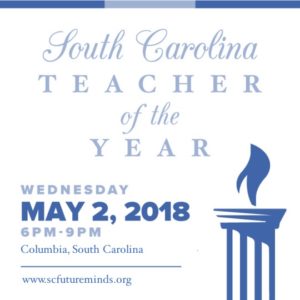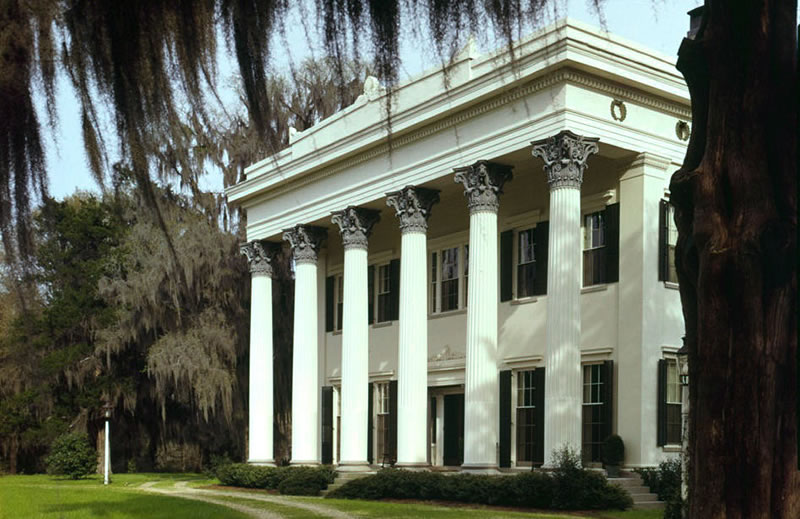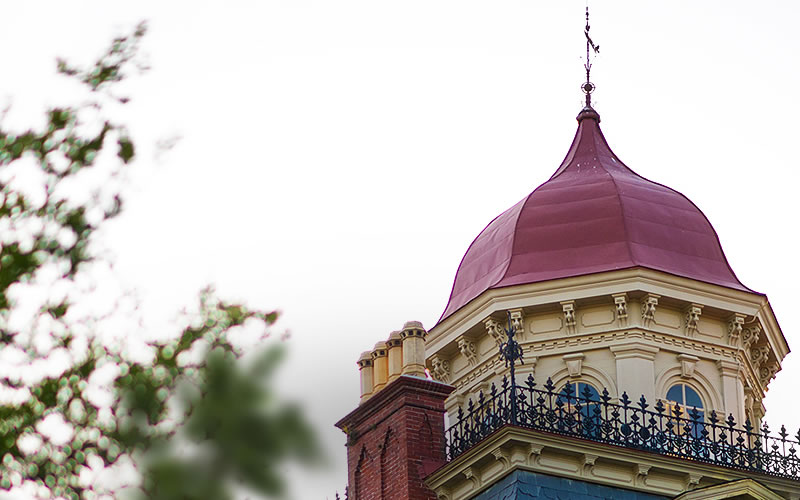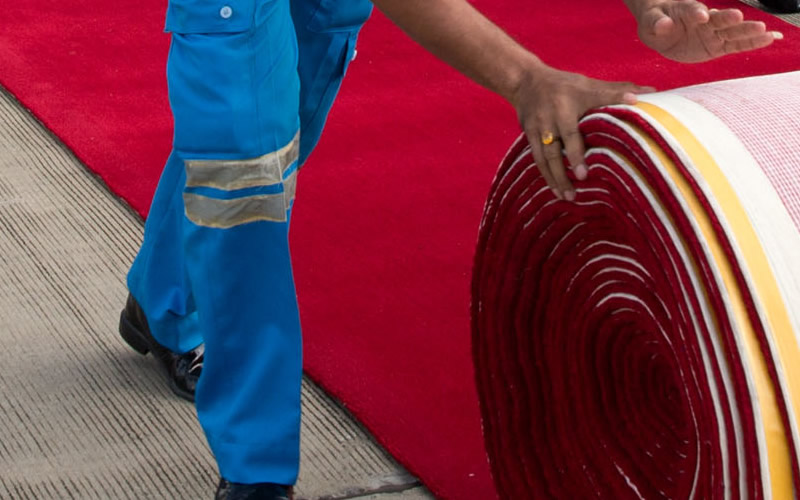MYSTERY PHOTO: At the top of the building
This week’s mystery focuses on the top of a South Carolina building. That’s the only clue you get. Send your guess to editor@charlestoncurrents.com with “Mystery Photo” in the subject line. Please make sure to include your name and contact information.
Last issue’s mystery
 The April 23 Mystery Photo, scrubbed by us of the identifying name carved in stone, showed the J. Waites Waring federal courthouse annex near the Four Corners of Law at Meeting and Broad streets. Once named for former U.S. Sen. Fritz Hollings, the retired senator asked a few years ago for his name to be removed so it could honor Waring, a judicial lion ahead of his time with rulings to desegregate the South.
The April 23 Mystery Photo, scrubbed by us of the identifying name carved in stone, showed the J. Waites Waring federal courthouse annex near the Four Corners of Law at Meeting and Broad streets. Once named for former U.S. Sen. Fritz Hollings, the retired senator asked a few years ago for his name to be removed so it could honor Waring, a judicial lion ahead of his time with rulings to desegregate the South.
Congratulations to several eagle-eyed sleuths for correctly identifying the photo: Chris Books of Mount Pleasant; Joe Mendelsohn and James McMahan, both of Charleston; Elizabeth P. Stevens of Mobile, Ala.; George Graf of Palmyra, Va.; Tom Tindall of Edisto Island; Archie Burkel of James island; and Kristina Wheeler of West Ashley.
Graf shared some of the story about Waring, according to SCETV.org: “Perhaps Waring’s most famous legal opinion was a dissent issued in the case of Briggs v. Elliott. Filed on Dec. 22, 1950, by NAACP lawyers on behalf of the parents of black students, Briggs indicted School District 22 with upholding unequal conditions in the black and white schools of Clarendon County, South Carolina. While white students were transported by bus, black students had to walk up to nine miles to reach their schools, since no buses were provided. Conditions inside of black schools lacked indoor plumbing, running water, and were typically heated only by wooden stoves. Attorneys for the plaintiffs argued that separate and segregated schools were unconstitutional.
“Waring, along with Judges Parker and Timmerman, was appointed to the three-judge panel set to hear the case. The plaintiffs lost their case by a 2 to 1 vote, but Waring’s scathing dissent became well publicized. The judge deemed segregation to be “an evil that must be eradicated” and proclaimed, “Segregation is per se inequality.” On appeal, the Supreme Court upheld the original court’s decision in Briggs. That same day Waring announced his retirement.”
Tindall provided more context, based on information from the U.S. General Services Administration:
“The mystery photo is of the J. Waties Waring Judicial Center, located at 83 Meeting Street in Charleston. The J. Waties Waring Judicial Center was constructed in 1988 as an annex building in downtown Charleston’s federal complex. It abuts the 1890s-era U.S. Post Office and Courthouse and was originally named the Hollings Judicial Center in honor of former U.S. Senator Ernest “Fritz” Hollings. The Judicial Center, Post Office, Courthouse and Josiah House constitute one anchor in Charleston’s renowned “Four Corners of the Law,” which is completed by Charleston City Hall, the County Courthouse, and St. Michael’s Episcopal Church.
U.S. Sen. Lindsey Graham and U.S. Rep. James Clyburn introduced legislation renaming the facility at the behest of former Senator “Fritz” Hollings. Public Law 114-48 designating the J. Waties Waring Judicial Center was approved by the U.S. Congress and signed by President Obama in August 2015. The re-dedication ceremony also included a special tribute to the 93-year-old Hollings who served six terms in the U.S. Senate and retired in 2004 as the eighth-longest-serving senator in U.S. history. While in office, Hollings supported civil rights and concentrated on the plight of the poor in South Carolina.
“Charleston native Judge Julius Waties Waring, the son of a Confederate veteran, was nominated to the federal court bench by President Franklin Roosevelt in 1942. He assumed the bulk of the South Carolina U.S. District Court’s civil rights docket and issued landmark rulings on black teacher pay disparities, voter disenfranchisement and school segregation cases.
“Waring’s 1951 Briggs v. Elliott opinion was America’s first federal judicial record to hold that government-mandated segregation violated the Fourteenth Amendment to the U.S. Constitution. Waring asserted that “Segregation is per se inequality.” The U.S. Supreme Court upheld Waring’s dissent and relied on his language and reasoning in casting its unanimous 1954 decision declaring the “separate but equal” doctrine unconstitutional in Brown v. Board of Education, which consolidated Briggs and other school segregation cases. Waring’s challenges to the racially-discriminatory practices of that era came at great personal expense, as he and his family were vilified and received constant death threats. Waring retired from the bench in 1952 and moved to New York City, where he died on Jan. 11, 1968, at age 87.
Send us a mystery: If you have a photo that you believe will stump readers, send it along (but make sure to tell us what it is because it may stump us too!) Send it along to editor@charlestoncurrents.com.
IN THIS ISSUEMYSTERY PHOTO: At the top of a building
FOCUS, Mauldin: Public school teachers are stewards of our future
COMMENTARY, Brack: Seize the rudder to thwart ambivalence, apathy, neglect
IN THE SPOTLIGHT: Charleston Gaillard Center
PALMETTO POEM, Pearce: Notes from the Quarterly Training Session
WHAT WE LOVE: Minor league baseball
GOOD NEWS: CofC program ranks first in the nation
FEEDBACK: Send us your thoughts
S.C. ENCYCLOPEDIA: Plantations and the plantation system
CALENDAR, April 30+: On the Table’s pilot debuts Tuesday
FOCUSFOCUS: Public school teachers are stewards of our future
By Caroline Mauldin, special to Statehouse Report | The lights are low as 700 people collectively hold their breath. A drum rolls, followed by the crinkle of an envelope opening. “And the winner is…!” Gasps and applause fill the room as the audience jumps to their feet in pride, and the winner shuffles up to the stage in disbelief.
No, this is not a scene from the Academy Awards in Los Angeles, but one much closer, and more significant to our state: it is South Carolina’s Teacher of the Year gala, held every May in Columbia.
Just over 10 years ago, a group of business leaders recognized a simple fact: if we want to recruit top talent to teach in South Carolina’s public schools, we need to show that we value teachers. It was from this basic idea that South Carolina Future Minds, a statewide nonprofit, was born and exists today. Since then, we have worked with leading companies, like BMW and Bojangles’, to throw a red-carpet celebration honoring some of South Carolina’s community heroes: our public school teachers.
The evening is a highlight for anyone remotely invested in South Carolina’s public schools: for one night, legislators, business executives and civic leaders see teachers as their students do every day: inspirational, committed, passionate role models who are guiding us into the future.
South Carolina’s public school teachers are indeed stewards of our future. By fostering young minds to be critical and creative thinkers, they are preparing an agile workforce that will be able to adjust and thrive in a changing economy. By showing up every day for our children, they are pillars of every community in the state, especially those that are increasingly under-resourced and struggling to survive. And by choosing a career of service and leadership, they are doing more to ensure the state’s prosperity than most—and certainly more than we give them credit for.
South Carolina can and should be proud of our public school educators. We should also be proud of how we celebrate them at the Teacher of the Year gala every May. What we need to work on is how we, as a society, treat them the rest of the year.
A recent study shows that teacher salaries have actually declined in past decades as cost of living has increased. In South Carolina, we’ve seen a 6 percent decrease since 2000, whereas salaries for other college graduates are increasing. Meanwhile, our legislature has set a lower starting salary than those found in neighboring North Carolina and Georgia, and our average teacher salary lags behind the Southeastern average. All this—even as our state experiences steady economic and population growth.
 Of course, salary isn’t everything, particularly for a segment of the workforce that feels called to serve their communities. Most educators will tell you they don’t do it for the money; they do it for the kids.
Of course, salary isn’t everything, particularly for a segment of the workforce that feels called to serve their communities. Most educators will tell you they don’t do it for the money; they do it for the kids.
But from the perspective of supply and demand, consider this: what happens when you start with a statewide teacher shortage (500-plus vacancies in the 2017-18 school year), add a growing student population with increasingly diverse demands, and decrease the number of new teachers entering the profession, as another recent study has shown?
Adam Smith, father of the free market, would point to the invisible hand: increase supply via compensation or other competitive incentives in order to bring equilibrium back. Of course, government-run sectors, like the public education system, do not represent a free market; but that doesn’t mean we can’t learn from its basic principles.
The challenge, of course, is convincing the powers-that-be of the urgency of our teacher crisis, and the bottom line for them is this: we are limiting our collective potential by shortchanging our teachers today.
South Carolina is fortunate to have a strong business community that recognizes the critical role of educators in our society. Many of them will come together next week as we crown the 2019 South Carolina Teacher of the Year. The evening will be unforgettable to all those we honor that night; but, for my part, the work will not be done until South Carolina’s policymakers follow our lead and value teachers all year long.
Caroline P. Mauldin is the executive director of South Carolina Future Minds, a statewide organization investing in public education as a driver of economic and social progress. She is a native of Columbia and currently resides in Charleston.
- Have a comment? Send to: editor@charlestoncurrents.com
BRACK: Let’s seize the rudder to thwart ambivalence, apathy, neglect
By Andy Brack, editor and publisher | With the annual legislative session roaring to a close, there are a multitude of unresolved issues, as usual.
 Most prominent is the state’s nuclear mess, a $9 billion fiasco stemming from a nuclear plant project that failed last year without generating a watt of power. Currently, the state House and Senate are mired in working out differences in how to deal with this issue that has consumed hours and hours of legislative time.
Most prominent is the state’s nuclear mess, a $9 billion fiasco stemming from a nuclear plant project that failed last year without generating a watt of power. Currently, the state House and Senate are mired in working out differences in how to deal with this issue that has consumed hours and hours of legislative time.
Years ago, the General Assembly wrote a law that has allowed SCE&G, the majority partner in the unsuccessful Fairfield County project, to charge fees to ratepayers to help pay for the facility as it was being built. But now with the abandoned site being little more than humongous chunks of concrete, there’s still debt – and the utility wants to keep charging, claiming it might go bankrupt otherwise.
Not so fast, the legislature has said for months, pounding on bully pulpits that the gouging of ratepayers has to stop. At issue now in these waning days of the session is whether to cut the full amount of extra payments by 18 percent, an amount sought by the House and Gov. Henry McMaster, or go with a 13 percent cut, which the Senate prefers because it doesn’t want SCE&G to face financial peril.
A compromise must be forged. We say split the difference at 15 percent. Otherwise, there may be nothing to show for a nuclear debacle that has sucked the life out of a host of other challenges, such as education, health care and poverty, that lawmakers should have been dealing with.
House members want a deal. Otherwise, they’ll face angry voters at the polls in November. But if a deal isn’t hammered out, the state Public Service Commission will decide on the issue at the end of the year when it also considers a multi-billion-dollar pitch by Dominion Energy to take over SCE&G and its parent, SCANA.
Let’s now shift to some other topics:
Is it only me? State officials announced all sorts of emergency measures to improve security after seven inmates died in a bloody melee at Lee Correctional Institute a few days back.
McMaster issued an emergency order to allow the understaffed state Department of Corrections to stop following state hiring regulations so it can boost pay and hire staff more quickly to fill 600-plus openings at state prisons. Makes sense.
But notice this paragraph from a story in The State newspaper about the order:
“McMaster’s order also allows the prisons agency to avoid the state’s lengthy procurement system to buy and install $7 million in netting at 11 higher-security prisons that could stop contraband from being tossed over prison fences.”
What? State lawmakers and corrections officials have known for years that prisons have been a powder keg waiting to explode. What happened in Bishopville wasn’t surprising. But the story suggests the state knew of a way to improve security but hadn’t done it because of its own procurement rules. How much sense does that make?
Unfortunately, this is typical of South Carolina leadership. There has to be a horrible problem or a really squeaky wheel before anything gets done. Witness disastrous property tax reform, the years it took to pass a gas tax people wanted for better roads, and now the challenges with holding utilities accountable for their failures.
Be careful about the development you hope for. Overdevelopment in popular parts of the state is another looming challenge.
Think about the South Carolina you love. Is it a complex of new buildings? A four-lane expressway? A skyline of cranes? Traffic congestion?
No. It’s a park, a beach, a lake, the great outdoors. But as more people move into South Carolina, particularly in the metros, there’s so much bowing to the altar of rampant development that we’re slowly eroding what’s special about South Carolina.
All of these things – unsafe prisons, failing infrastructure, leaders who don’t know how to lead, unmet challenges that spin out of control– illustrate the need for comprehensive planning at state and local levels.
Let’s seize the rudder. Let’s shout for leaders to stop dawdling and plan our future instead of letting it be thrust onto us through exploitation, neglect, ambivalence and apathy.
- Have a comment? Send to: editor@charlestoncurrents.com
SPOTLIGHT: Charleston Gaillard Center
 Charleston Gaillard Center provides the Lowcountry with a world-class performance hall, elegant venue space and vibrant educational opportunities that inspire dynamic community throughout the area through the power of the performing arts. The Center’s vision is to enrich the diverse community of Charleston with artistic and cultural experiences that are accessible and unique, and to serve as an educational resource for generations to come.
Charleston Gaillard Center provides the Lowcountry with a world-class performance hall, elegant venue space and vibrant educational opportunities that inspire dynamic community throughout the area through the power of the performing arts. The Center’s vision is to enrich the diverse community of Charleston with artistic and cultural experiences that are accessible and unique, and to serve as an educational resource for generations to come.
Did you know that the Charleston Gaillard Center is a 501c3 non-profit that works with over 25,000 students each year from the tri-county area? Promoting education is one of the core values of the Charleston Gaillard Center and an integral part of our mission. By broadening the reach of arts-education in the Lowcountry the Gaillard Center encourages learning through the arts and serves as a powerful tool for student achievement and personal development while providing people of all ages with the opportunity to cultivate and grow their talents and appreciation for the arts. To learn more about our education initiative, click here: www.gaillardcenter.org/outreach.
For more information, click the links below:
- Buy ticketsand see our great events
- Become a membertoday
- Plan your eventat the Charleston Gaillard Center
- Learn aboutour education and community programs h
- Contact the Gaillard Center.
PEARCE: Notes from the Quarterly Training Session
By Frances Pearce, special to Charleston Currents
Barred tail feathers, round brown face.
I wish you would wake, wish you could.
In this sleeping posture – lying
on your back (unnatural, I know),
you appear relaxed.
I watch as Curtis cuts away your skin,
slices open your chest cavity.
We identify the interclavicular air sac.
Stacy and Keely tell us spreading
wings increases oxygen flow.
But it’s too late for that. You’re dead,
frozen weeks ago, awaiting this dissection.
Today we locate your trachea, with tweezers
stretch your worm-like intestines, open,
for you, your beak, lift your boned tongue.
I stand back, focus on your barred
tail feathers, your brown owl face,
imagine you alive,
imagine you soaring,
moving away into the night.
Frances J. Pearce is a poet, essayist, and fiction writer. She is the author of a poetry chapbook Those Carolina Parakeets Once Far from Extinct and a completed novel manuscript. Her writing has been published in Archive: South Carolina Poetry Since 2005, Good JuJu Review, Fall Lines, Kakalak, and The Saturday Evening Post. She lives in Mount Pleasant and serves as president of the Poetry Society of South Carolina. The poem above was first published in Those Carolina Parakeets Once Far from Extinct (Finishing Line Press, 2014).
WHAT WE LOVEWHAT WE LOVE: Minor league baseball
Way back when the tough-sounding RiverDogs were known as the Rainbows – yes, perhaps one of the worst names ever for a baseball team – we remember one particular game where enthusiasts had a game of drinking a beer (ahem, quickly) for every error made in the game. During this particular contest, however, these sudsy fans had to leave after the first inning, thanks to seven errors.
![]() All of that being said, minor league ball at Joe Riley Stadium is a thrill to behold. It’s a thoroughly enjoyable experience with cold beer, hot dogs, boiled peanuts and great action. There’s excitement after each half inning with special contests and races. And then there’s the wacky promotions that draw fans and import delight. It’s also fun watching kids learn the game and seniors recall how it was back in the days of yore.
All of that being said, minor league ball at Joe Riley Stadium is a thrill to behold. It’s a thoroughly enjoyable experience with cold beer, hot dogs, boiled peanuts and great action. There’s excitement after each half inning with special contests and races. And then there’s the wacky promotions that draw fans and import delight. It’s also fun watching kids learn the game and seniors recall how it was back in the days of yore.
If you’ve gotten this far in this testimony about what we love about the RiverDogs, be the third person to correctly answer this question and win a pair of tickets: What franchise was affiliated with the franchise when Charleston’s team was known as the Rainbows? Send your answer to: editor@charlestoncurrents.com and make sure to include your contact information.
Now, what do you love about Charleston and the area?
Tell us what you live about the Lowcountry
Tell us what you love. Send a short comment – 50 words to 100 words – that describes something you really enjoy about the Lowcountry. It can be big or small. It can be a place, a thing or something you see. It might the bakery where you get a morning croissant or a business or government entity doing a good job. We’ll highlight your entry in a coming issue of Charleston Currents. We look forward to hearing from you.
GOOD NEWSGOOD NEWS: CofC program ranks first in the nation
Staff reports | Hats off to the College of Charleston School of Business MBA program, which has been ranked first in the nation for job placement, according to U.S. News & World Report. The college’s accelerated one-year MBA program tied for first with Northern Arizona University for job placement three months after graduation, according to a press release.
School of Business Dean Alan Shao credited the region’s job network at a driver: “The school has an unparalleled relationship with local business leaders who offer their expertise not only as mentors and lecturers but as employers, often providing MBA students with career and internship opportunities.”
Beer on tap. Charleston’s Lee brothers have penned an outstanding story for The New York Times on the Holy City’s burgeoning “Brewery District,” a group of seven breweries and tap rooms in and around Morrison Drive in the Neck part of town. It highlights yet another novel Charleston experience. Read here.
Best museum. The Gibbes Museum of Art has been named South Carolina’s top museum in this recent feature by USA Today. The story says the museum is “known for: South Carolina history experienced through art.” On May 3, the museum will hold its annual Street Party with a world-class line-up of chefs. This year’s theme: “Paint Your Palate.” Time: 7:30 p.m. to 10 p.m. Tickets: $150 for museum members. More info.
Piccolo Spoleto program available. You can now find details of the 2018 Piccolo Spoleto Festival through this downloadable program and ticketing system at PiccoloSpoleto.com. If you prefer to get tickets in person, you can order them at Charleston Gaillard Center, 95 Calhoun St., Charleston, starting May 1. This year’s 17-day festival, the annual outreach arm of Spoleto Festival USA, will offer more than 500 performing, literary and visual arts events.
Closed Mondays, Tuesdays. Here’s some not-so-good news: Starting today, the Charles Pinckney National Historic Site will be closed Mondays and Tuesdays as the part is reviewing park operations, including the hours it is open, according to a press release. “The park is evaluating how to best operate the site and develop new strategies to offer quality visitor experiences, provide visitor and staff safety, while protecting the historical and natural resources of the park. Several key staff positions have been recently vacated and are in the process of being filled.” The park’s hours are 9 a.m. to 5 p.m., Wednesdays through Sundays. More info.
- Have a comment? Send to: editor@charlestoncurrents.com
FEEDBACK: Send us your thoughts
We love hearing from readers. Comments are limited to 250 words or less. Please include your name and contact information. Send your letters to: editor@charlestoncurrents.com| Our feedback policy.
S.C. ENCYCLOPEDIAHISTORY: Plantations and the plantation system

Milford Plantation, Sumter County. Financier Richard Jenrette, who restored the plantation, died earlier this week. Photo via Wikipedia.
S.C. Encyclopedia | In the seventeenth century the term “plantation,” which formerly referred to any colonial outpost, evolved to refer specifically to large agricultural estates whose land was farmed by a sizable number of workers, usually slaves, for export crops. Englishmen initially created plantation societies in the West Indies, and in the 1670s South Carolina became a northern extension of this empire.
Plantations distinguished themselves from smaller farms not only by the sheer size of their landholdings and workforce but in other ways as well. There was a distinct separation between owners, overseers (managers), and the labor force. Evidence of this separation could be found in plantation housing patterns. Laborers were housed in often shoddy, crowded cabins clustered in a village or “street” at some remove from the owner’s residence. While plantation “big houses” were mostly modest affairs, they sometimes reached uncharacteristic levels of opulence. These more elaborate residences became fixtures in an enduring plantation mythology. The Georgian and Greek-revival mansions popularized in romantic fiction were more the exception than the rule.
An additional defining element of plantations was their focus on one commercial crop. Although South Carolina planters grew a little tobacco in the early years, rice became the colony’s most important staple, and in the years prior to the Revolutionary War, a full-scale plantation culture worked by African slaves emerged along the rivers of the Carolina Lowcountry. The success of rice culture was due in large part to the agricultural skills of the slaves, many of whom hailed from rice-growing regions of Africa. An innovative development in rice culture was tidal irrigation. Water was drawn on and off the crop through an elaborate system of dams, canals, and gates. The landscape was dramatically altered, profits soared, and rice planters became some of the wealthiest people in North America. Planters typically divided their time between their country seats and residences in “town,” moving to Charleston, Georgetown, or Beaufort for a winter social season and relief from the threat of malaria in summer.
The plantation system, in a modified form, spread inland, with cotton fueling the expansion. In the early 1800s cotton culture was lucrative, and many planters plowed their profits into acquiring more land and slaves. Thus, medium-sized farms could grow into plantations within a few years. By 1820 South Carolina was producing more than half the nation’s total output of cotton. Although “King Cotton” continued to rule the state’s economy in the antebellum decades, the center of cotton culture in America gradually moved west into Georgia, Alabama, Mississippi, Arkansas, and Texas.
The North’s opposition to the continued expansion of slavery was the primary factor compelling South Carolina’s secession from the Union, which set in motion the Civil War. Southern defeat resulted in the emancipation of the slaves and profound changes in southern agriculture. A common misconception is that when slavery ended, the plantation system collapsed. In reality, plantations were defined more by the size of their workforce than the status of the workers. Many South Carolina plantations survived the postwar years in a modified form dubbed “fragmented plantations” by geographers. These surviving plantations differed from antebellum properties in important ways. Sharecropping and tenantry replaced slavery as a labor system, and laborers were disbursed across the property rather than concentrated in a central location. Despite this reconfiguration brought about by the end of slavery, many freed people noticed little difference between their former and current living standards. Indeed, they frequently continued to live and work on the property of their former masters.
From the 1870s through the 1890s, southern agriculture entered a long decline and in most cases never regained antebellum levels of prosperity. South Carolina plantations met a variety of fates. As taxes and maintenance costs outpaced profits, many properties were sold off piecemeal by descendants unable to maintain them. But from the fertile soil of others, emblems of the New South sprang forth. Wealthy northerners purchased many former rice plantations in the late nineteenth and early twentieth centuries, transforming them into hunting preserves. Since the 1970s other former rice plantations have become upscale housing developments and golf communities. Further inland, abandoned plantation lands have frequently been harvested for their timber rather than cotton. Due to preservation and restoration efforts, however, in the early twenty-first century some 150 antebellum plantation houses remained in the Lowcountry alone, and these estates, still an evocative symbol of the Old South, continued to be a powerful draw for the state’s tourist industry.
— Excerpted from an entry by Robert Stevens. To read more about this or 2,000 other entries about South Carolina, check out The South Carolina Encyclopedia, published in 2006 by USC Press. (Information used by permission.)
ON THE CALENDARCALENDAR, April 30: On the Table discussions set for Tuesday around the region
 Staff reports | Hundreds of people will meet to have their say about what matters to them locally in dozens of pilot meetings for On the Table Lowcountry discussions set for May 1.
Staff reports | Hundreds of people will meet to have their say about what matters to them locally in dozens of pilot meetings for On the Table Lowcountry discussions set for May 1.
As first highlighted by Charleston Currents in this story, On the Table Lowcountry is a grassroots effort to bring together people in small gatherings of up to 10 people to talk about what’s good, what needs changing and what we can do to improve lives and conditions across the region.
The discussions throughout the day, a leadership project of the new Library Foundation of the Lowcountry, give everyone participating a chance to have their say about issues they care about. All of the information – a kind of community-wide focus group — will be collected and offered to area governments and nonprofits. Furthermore, the May 1 event serves as a pilot for what organizers hope will be hundreds of On the Table discussions on Sept. 27 involving thousands of area residents.
- Learn more here: On the Table Lowcountry.
Also on the Calendar:
![]() GoodSpring fund-raiser: 6 p.m. to 9 p.m. April 30, Mira Winery, 68½ Queen St., Charleston. CharlestonGOOD is holding a spring fundraiser to be able to develop a new summer project as it continues to host collaborative gatherings. This event will include live music, art, food from Butcher & Bee and wine rom Mira. Tickets are $50. More: CharlestonGOOD.com
GoodSpring fund-raiser: 6 p.m. to 9 p.m. April 30, Mira Winery, 68½ Queen St., Charleston. CharlestonGOOD is holding a spring fundraiser to be able to develop a new summer project as it continues to host collaborative gatherings. This event will include live music, art, food from Butcher & Bee and wine rom Mira. Tickets are $50. More: CharlestonGOOD.com
Free skin checks. Dermatologists and certified dermatological providers from Dermatology and Laser Center of Charleston will offer free skin cancer screenings for new patients on May 1 and 15. The screenings will take place at the offices of Dermatology and Laser Center of Charleston 5 p.m. to 7:30 p.m. May 1 at 2180 Henry Tecklenburg Drive, West Ashley (behind Lowe’s), and at the same time May 15 at 1364 Ashley River Road, West Ashley. Registration for the event is required and may be made by phoning 843-556-8886, visiting their website www.dermandlaser.com.
Wine Down Wednesdays: 5:30 p.m. to 7:30 p.m., on May 2, Old Towne Creek County Park, West Ashley. While this new county park is not yet open daily to the public, these Wednesday opportunities offer Lowcountry residents the chance to experience the beauty of this property. Tickets needed. More: CharlestonCountyParks.com/WDW.
Summey to speak: Noon, May 3, Halls Signature Events, 5 Faber St., Charleston. North Charleston Mayor Keith Summey, who runs the state’s third largest city, will offer remarks at a special small business lunch offered by King Street Marketing Group and Hall Management Group. Tickets are $31. Doors open at 11:30 a.m.
Learn about gerrymandering: 3:30 p.m. May 3, Mount Pleasant public library, 1133 Mathis Ferry Road. The League of Women Voters of the Charleston Area will explain gerrymandering and ways to address it through nonpartisan action. More information on gerrymandering can be found at the LWVCA website.
(NEW) Charleston Greek Festival: May 11 to May 13, Greek Orthodox Church, 30 Race St., Charleston. You can enjoy Greek food, dancing and culture at this 48th annual event said to be the city’s third largest festival. To learn more and find out about parking and directions, click here.
(NEW) A Frank discussion: Noon, May 15, Halls Signature Events, 5 Faber St., Charleston. Nationally-known and local author Dorothea Benton Frank will launch her new book, By Invitation Only, at a special talk and lunch as part of the Blue Bicycle Books author series. Doors open at 11:30 a.m. Cost is $62, which includes lunch and a signed book. More.
(NEW) Camp for young asthma sufferers: 10:30 a.m. to 2:30 p.m., May 19, Mary Ford Elementary School, 3180 Thomasina McPherson Blvd., North Charleston. Camp Breathe Easy is a one-day camp for children ages 6 to 13 who have been diagnosed with asthma. Parents are welcome too. It’s free, but registration is required. To apply, call the American Lung Association at 843.556.8451 or visit this website.
Early morning bird walks at Caw Caw: 8:30 a.m. every Wednesday and Saturday, Caw Caw Interpretive Center, Ravenel. You can learn about habitats and birds, butterflies and other organisms in this two-hour session. Registration not required, but participants are to be 15 and up. $10 per person or free to Gold Pass holders. More: http://www.CharlestonCountyParks.com.
AREA FARMERS MARKETS
SATURDAYS: The Charleston Farmers Market, is back in action from 8 a.m. to 2 p.m. every Saturday through Nov. 24 at Marion Square. A holiday market will be open Dec. 1, 2, 8. 9, 15 and 16.
SATURDAYS: Johns Island Farmers Market operates each Saturday from 10 a.m. to 1 p.m. year-round with more than 50 local farmers and vendors, food trucks, music and more. The market is located on the campus of Charleston Collegiate School, 2024 Academy Road, Johns Island.
SATURDAYS: The Town Market on James Island are again open. Open 9 a.m. to 1 p.m. every Saturday at the James Island Youth Soccer Club, 871 Fort Johnson Road, James Island.
TUESDAYS: The Town of Mount Pleasant’s Farmers Market is every Tuesday from 3:30 p.m. to 7 p.m. in the market pavilion at Moultrie Middle School, 645 Coleman Blvd, in Mount Pleasant.
WEDNESDAYS. The West Ashley Farmers Market, 55 Sycamore Ave., is open every Wednesday from 3 p.m. to 7 p.m. in Ackerman Park. More.
- If you have an event to list on our calendar, please send it to editor@charlestoncurrents.com for consideration. The calendar is updated weekly on Mondays.
OUR UNDERWRITERS
Charleston Currents is an underwriter-supported weekly online journal of good news about the Charleston area and Lowcountry of South Carolina.
- Meet our underwriters
- To learn more about how your organization or business can benefit, click here to contact us. Or give us a holler on the phone at: 843.670.3996.
OUR TEAM
Charleston Currents offers insightful community comment and good news on events each week. It cuts through the information clutter to offer the best of what’s happening locally.
- Mailing address: O. Box. 22261 | Charleston, SC 29413
- Phone: 670.3996
Charleston Currents is provided to you weekly by:
- Editor and publisher: Andy Brack, 843.670.3996
- Contributing photographer: Michael Kaynard
- Contributing editor, careers: Ben Fanning
- Contributing editor, common good, Fred Palm
- Contributing editor, money: Kyra Morris
- Contributing editor, Palmetto Poem: Marjory Wentworth
SUBSCRIBE FOR FREE
Subscriptions to Charleston Currents are free.
- Click here to subscribe.
- We don’t want to lose you as a reader of Charleston Currents, go to the bottom of any of your weekly newsletters and click the “unsubscribe” function. If that doesn’t work, please send us an email with the word “unsubscribe” in the subject line.
© 2008-2018, Statehouse Report, LLC. All rights reserved. Charleston Currents is published every Monday by Statehouse Report LLC, PO Box 22261, Charleston, SC 29413.












 We Can Do Better, South Carolina!
We Can Do Better, South Carolina!
























